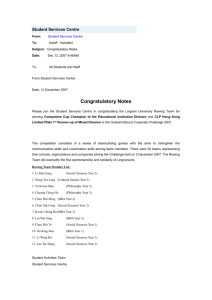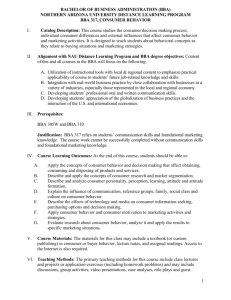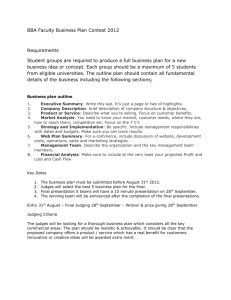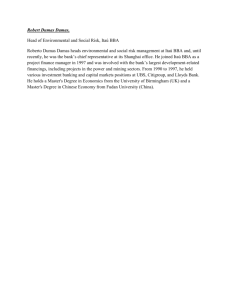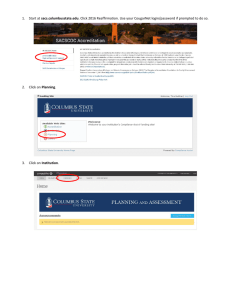NFκB - iGEM 2006
advertisement
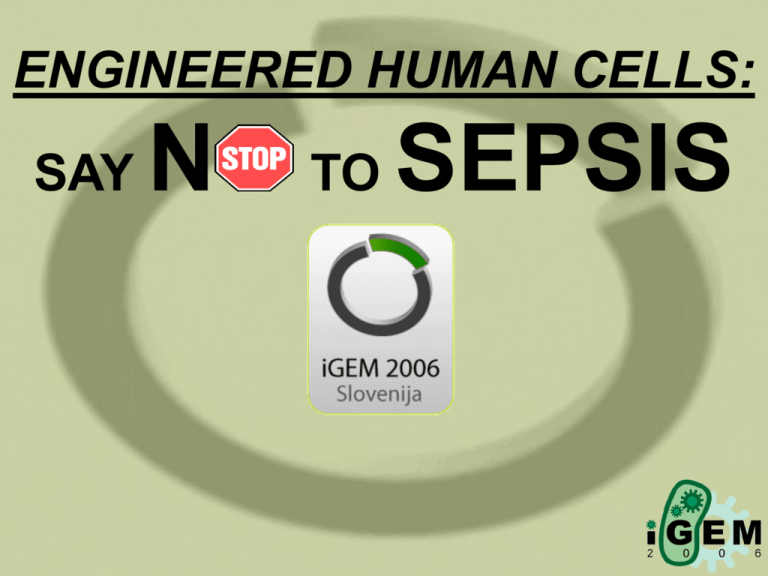
ENGINEERED HUMAN CELLS: SAY N TO SEPSIS We are from… Slovenia The Team Engineering of the logic of mammalian cells – More similarities than differences in comparison to prokaryotic systems – Disadvantages: more complex, slower and more expensive to work with – Opportunities: understanding of complex systems, relevant for potential medical application What is Sepsis? – Strikes 750,000 people per year in the US, similar numbers for the EU – In 1 of 5 cases it ends with death of the patient – Among the top 10 causes of death in the US What is Sepsis – Excessive inflammatory response triggered by pathogens – Widespread activation of inflammation and coagulation pathways infection inflammation What is Sepsis – Results in severe organ failure – Excessive reaction of host to the pathogen infection rather than bacteria causing pathology infection inflammation Toll-like receptors sense the presence of pathogens – main sensors of the innate immune response Toll-like receptor molecules: – 11 different human membrane receptores – recognize different molecules distinctive for pathogens TLRs and their agonists PAMP TLR IRAK1Kinase IRAK1Kinase DD MyD88 MyD88 IRAK4Kinase DD P TRAF6 P P TRAF6 TAK1 TAB1 P TAB2 TLR TLR P TRAF6 P P TAB2 IKKα IKKγ IκBα NFκB P NFκB P65/50 P TAB2 TRAF6TAK1 TAK1TRAF6 TAB1 TAB1 MEKK3 MEKK3 Ubc13 Ubc13 Uev1A Uev1A P65 TNFa IL-1 COX2... P P P IKKβ P TAK1 TAB1 nucleus P “All Paths lead through MyD88” MyD88 Our Project Basic concept: Inhibit the excessive cellular activation without of completely abolishing the cellular responsiveness Implementation: Insert into mammalian cells a feedback device with inhibitor (dnMyD88) that would repress the signaling of TLR pathway for a limited period of time. PEST sequence PEST PEST Gene Expression Mathematical Model Simplified model of TLR signaling Model with additional dnMyD88 feedback Cytoplasmic NF-kB Inflammatory mediators Nuclear NF-kB Normal cellular response to repeated stimulus Inflammatory mediators Cytoplasmic NF-kB Nuclear NF-kB Response to repeated stimulus in cells with inserted feedback device Our Parts Registration number Part's Name BBa_J52008 rluc BBa_J52010 NFκB BBa_J52011 dnMyD88-linker-rLuc BBa_J52012 rluc-linker-PEST191 BBa_J52013 dnMyD88-linker-rluc-link-pest191 BBa_J52014 NFκB+dnMyD88-linker-rLuc BBa_J52016 eukaryotic terminator BBa_J52017 eukaryotic terminator vector BBa_J52018 NFκB+rLuc BBa_J52019 dnTRAF6 BBa_J52021 dnTRAF6-linker-GFP BBa_J52022 NFκB+dnTRAF6-linker-GFP BBa_J52023 NFκB+rLuc-linker-PEST191 BBa_J52024 NFκB+dnMyD88-linker-rLuc-link-PEST191 BBa_J52026 dnMyD88-linker-GFP BBa_J52027 NFκB+dnMyD88-linker-GFP BBa_J52028 GFP-PEST191 BBa_J52029 NFκB+GFP-PEST191 BBa_J52034 CMV BBa_J52035 dnMyD88 BBa_J52036 NFκB+dnMyD88 BBa_J52038 CMV-rLuc BBa_J52039 CMV+rLuc-linker-PEST191 BBa_J52040 CMV+GFP-PEST191 BBa_J52642 GFP BBa_J52648 CMV+GFP Building of BioBricks: – Preparation of special fusion protein constructs with use of PCR Overlap Extension method – Cloning in BioBrick plasmids with ccdB domain – Construction of a modified vector with incorporated terminator – Construction of final Composites using of BioBrick assembly technique Transfection: Cell line: HEK293 - don’t express TLRs - have conserved signaling pathway Methods Detection systems to monitor the time course of the cellular response: - ELISA - Flow Cytometry - Luciferase Assay - Microscopy ELISA for the detection of free NF-kB peroxidase NF-kB streptavidin ELISA - Results Flow Cytometry for the detection of phosphorylated ERK Detection of transcriptional activation by luciferase assay Dual luciferase assay Two different luciferase reporter enzymes – The experimental reporter (NF-kB-fLuc) – The constitutive reporter gene (CMV-rLuc) Decreased steady state level and increased degradation rate of proteins with attached PEST tag Inducible expression of protein under the control of NF-kB promoter Why is there no inhibition ? DD luc X Polypeptide domain at the C-terminus of dnMyD88 prevents its interaction with TIR domain of TLR If true, it should work without of the C-terminal addition, does it ? Yes, the feedback device works! Conclusions • We have transferred the BioBrick principle into the mammalian cells using transient transfection. • We have succesfully implemented the feedback device that restricts the cellular activation in inflammation. • Our constructed device mimicks the natural mechanism of tolerance only that it is activated faster. • Simplified model of the TLR signaling qualitatively captures the main features of the signaling kinetics. Prospects for the future • Modulation of the lifetime of the inhibitor (and signal repression) based on the different rate of degradation by the addition of N-terminal PEST tag. • Construction of BioBrick vectors for stable transfection (additional resistance for cell culture lines). Hvala lepa

